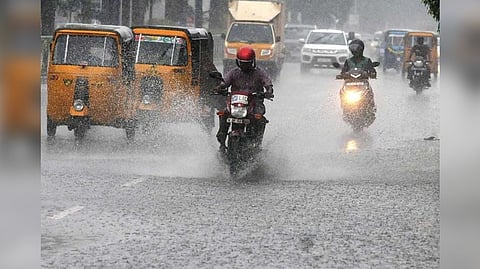

CHENNAI: Chennaiites might have realised by now how little it takes to turn traffic, and life in general, upside down in the city, with just the inkling of showers, compounded by storm water drain networks that underserve its citizens.
Sunday was a case in point as an unexpected drizzle that kicked off at about 9 pm snowballed into a downpour which saw many parts being inundated by rains uncharacteristic of the season.
An hour into the downpour, and some arterial roads witnessed waterlogging. Areas such as Egmore, T Nagar, Velachery, Saidapet, Santhome, Adyar and Thiruvanmiyur, some of the busiest stretches witnessed vehicular and traffic breakdowns thanks to stagnant water.
The case was similar in regions like Triplicane, Washermanpet, and Tambaram where rain threw life into a tizzy after midnight, over two days.
While petrol bunks were busy with vehicles that had broken down due to the entry of rainwater into exhaust pipes, there were more stories to tell the morning after.
In Ashok Nagar, trees were uprooted whereas in Tambaram, a subway connecting two railway stations had been inundated.
It’s a story that repeats ad infinitum in our metropolis, and we are left wondering what happened to the claims made by the administration regarding the upkeep of storm water drains.
It was in March that the Chennai Corporation had awarded tenders for storm water drains as part of the Singara Chennai 2.0 initiative.
A sum of Rs 186 cr had been earmarked for these projects that incorporate slabs that can be detached from the centre of the drain for better unclogging.
The Deputy Mayor had said all related works are expected to be completed by September 30 this year.
However, experts who had previously collaborated with the Corporation had pointed out that uneven gradients were one of the causes for flooding, especially in T Nagar and Mambalam.
The Corporation is entrusted with maintaining about 2,071 km of storm water drains along 8,835 stretches and around 30 canals in the city.
Drains running to a length of 1,070 km are being constructed at a cost of Rs 4,070 cr. Maintaining such a massive network is definitely not an easy task, but it is worth asking whether the Corporation’s work is proceeding as per schedule.
More importantly, will it be completed within the deadline of the approaching northeast monsoon? Earlier last week, the Corporation Commissioner had initiated legal action against three contractors who had delayed work on the drains being built as part of flood mitigation efforts.
Desilting of wells to collect storm water from subways is said to commence shortly while desilting of the drains are in progress in areas such as Tondiarpet and Thiru Vi Ka Nagar.
As per sources, work on 50% to 60% of the roads have commenced, so as to not inconvenience commuters by digging up all the roads at once. The Corporation’s priority is regions heavily inundated in the northeast monsoons last year.
But we are now living in a time when several parts of India are reeling from the unprecedented fallouts of climate change and extreme weather events — from life-threatening heat waves to devastating landslides and floods.
So, the Corporation must pull up its socks and prepare not only for emergencies expected during a certain season, but for those that might be an all-year round recurrence.
The imperative for Chennai is to avoid crippling the city with makeshift arrangements, and focussing on long term measures to build back better and in a more resilient manner, knowing fully well that such unexpected weather conditions are here to stay.
Visit news.dtnext.in to explore our interactive epaper!
Download the DT Next app for more exciting features!
Click here for iOS
Click here for Android